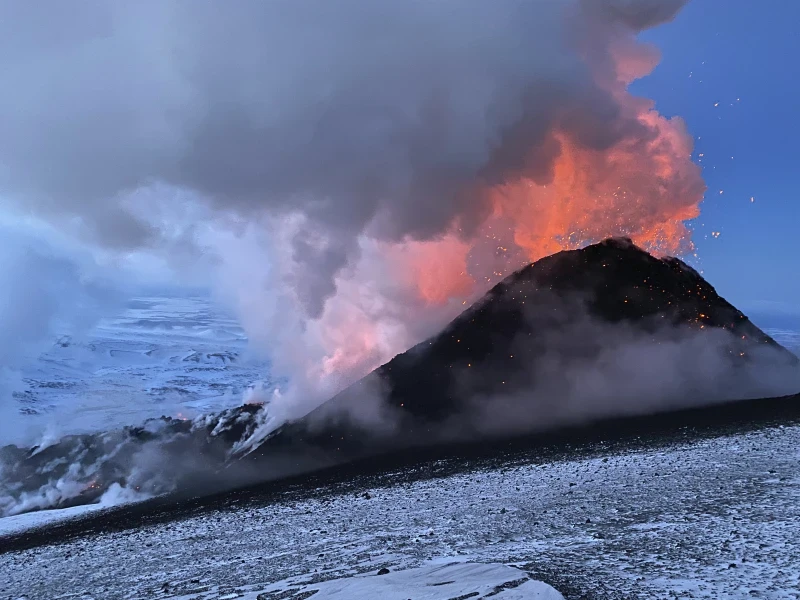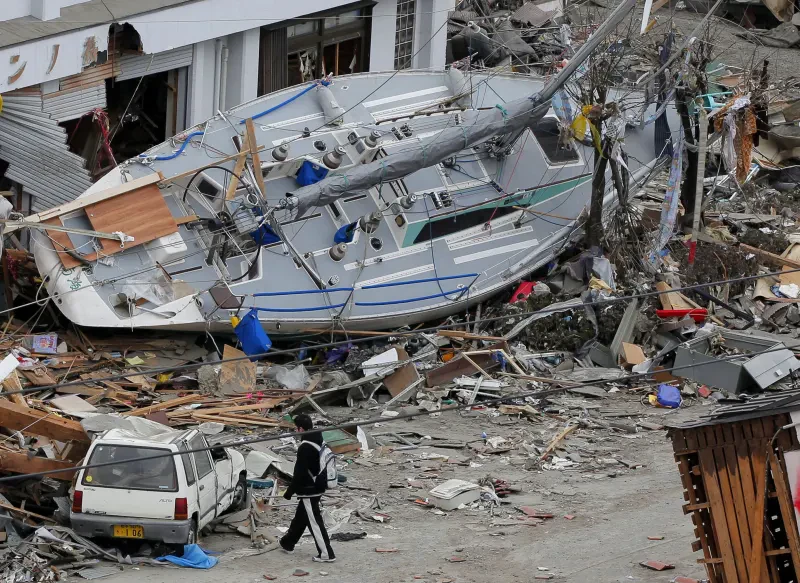Millions remain under tsunami advisories following powerful earthquake
A tsunami has hit coastal areas of Russia’s Kuril Islands and Japan’s large northern island of Hokkaido after an 8.8-magnitude earthquake early Wednesday.Wednesday, July 30th 2025, 11:21 am
One of the strongest earthquakes ever recorded struck off Russia’s sparsely populated Far East early Wednesday, sending tsunami waves into Japan, Hawaii and the U.S. West Coast.
Several people were injured, but none gravely, and no major damage has been reported so far. Authorities warned the risk from the 8.8 magnitude quake could last for hours, and millions of people potentially in the path of the waves were initially told to move away from the shore or seek high ground.
RELATED STORY: How do tsunamis form? What to know after Russia's earthquake
What to know:
- Some advisories and warnings are still in effect: Much of the coastline for Chile is under the highest level of alert. The worst appeared to have passed for many areas, including the U.S., Japan and Russia. Authorities in Hawaii downgraded the state to a tsunami advisory early Wednesday, and evacuation orders on the Big Island and Oahu, the most populated island, were lifted.
- Even under an advisory, the risk remains: An advisory means there is the potential for strong currents and dangerous waves, as well as flooding on beaches or in harbors. A tsunami height of 3 to 4 meters (10 to 13 feet) was recorded in Kamchatka, and waves of 60 centimeters (2 feet) were recorded on Japan’s northern island of Hokkaido. In Northern California, officials recorded waves of 3.6 feet (1.1 meters) in Crescent City.
- Earthquake was one of history’s strongest: The quake struck at 8:25 a.m. Japan time with a magnitude of 8.8 and a depth of about 21 kilometers (13 miles), according to the U.S. Geological Survey. It was centered about 120 kilometers (75 miles) from the Russian city of Petropavlovsk-Kamchatsky. Multiple aftershocks as strong as 6.9 magnitude followed.
Colombia orders evacuation of beaches
9:58 a.m. CDT—Officials in Colombia have ordered the complete closure and evacuation of beaches and low-tide areas along the country’s Pacific coast.
Maritime traffic is also being restricted. Officials say strong currents and tsunami waves were possible in two coastal states, including one that borders Ecuador.
DHS secretary says the threat of a tsunami hitting the US has ‘passed completely’
By ISABEL DEBRE
8:57 a.m. CDT—U.S. Secretary of Homeland Security Kristi Noem, in Chile for meetings with officials, told reporters in the capital of Santiago that the threat of a major tsunami hitting the United States “has passed completely.”
“We’re in really good shape right now,” Secretary Noem said, according to a White House pool report. “We were fully deployed and ready to respond if necessary, but grateful that we didn’t have to deal with the situation that this could have been.”
 U.S. Homeland Security Secretary Kristi Noem makes remarks with Chile’s Minister of Public Security Luis Cordero after signing a letter of intent for a Biometric Identification Transnational Migration Alert Program (BITMAP), at the Security Ministry in Santiago, Chile, Wednesday, July 30, 2025. (AP Photo/Alex Brandon, Pool)
U.S. Homeland Security Secretary Kristi Noem makes remarks with Chile’s Minister of Public Security Luis Cordero after signing a letter of intent for a Biometric Identification Transnational Migration Alert Program (BITMAP), at the Security Ministry in Santiago, Chile, Wednesday, July 30, 2025. (AP Photo/Alex Brandon, Pool)
Lava has begun to flow from the largest active volcano in the northern hemisphere following the earthquake
8:50 a.m. CDT—The Klyuchevskaya Sopka stands at 4,750 meters or 15,584 feet in the east of Russia’s Kamchatka region. Observers heard explosions and saw streams of lava on the volcano’s western slopes, the Kamchatka branch of the Russian Academy of Sciences’ geophysical service said.
Scientists have anticipated the eruption for some time, with the volcano’s crater filling with lava for several weeks and the mountain spitting out plumes of ash. Sometimes described as the “land of fire and ice,” Kamchatka is one of the most active volcanic regions in the world. it has about 300 volcanoes, 29 of them still active, according to NASA Earth Observatory.
The Klyuchevskaya Sopka last erupted in 2023.
 Flames and smoke billowed during the Klyuchevskaya volcano’s eruption on the Kamchatka Peninsula in Russia, on March 8, 2021. (AP Photo/Boris Smirnov, File)
Flames and smoke billowed during the Klyuchevskaya volcano’s eruption on the Kamchatka Peninsula in Russia, on March 8, 2021. (AP Photo/Boris Smirnov, File)
Chile’s national emergency service says it is evacuating hundreds of people from coastal areas
By ISABEL DEBRE
8:38 a.m. CDT—“Remember that the first wave is usually not the strongest,” Chilean President Gabriel Boric warned on social media. “Let’s act calmly and follow official instructions.”
Chile ranks among the countries that are most vulnerable to earthquakes and subsequent tsunamis, and Chileans have painful memories of an 8.8-magnitude quake in 2010 that killed 525 people, many of them in the tsunami that followed.
California city urges people to stay away from beaches
7:42 a.m. CDT—Officials in Crescent City issued the warning after the 8.8 magnitude earthquake off Russia’s coast provoked tsunami waves.
Crescent City has observed dozens of tsunamis since the 1930s, including one that killed 11 people and destroyed hundreds of buildings in the city in 1964.
That event is considered the worst tsunami disaster recorded in the United States. The city’s downtown area was mostly rebuilt and today a walking tour highlights high-water marks posted on surviving buildings.
Japan downgrades its last remaining tsunami alert
7:13 a.m. CDT—That alert was in the country’s north.
Tsunami advisories remain in place for Japan’s Pacific coast following the 8.8 magnitude quake that struck off Russia’s Far East.
2 regions cancel tsunami warnings
7 a.m. CDT—Russian authorities on the Kamchatka Peninsula and Kuril Islands have canceled their tsunami warnings but say the risk of aftershocks and waves remains.
The regional branch of Russia’s Emergency Ministry on Kamchatka warned that scientists expect aftershocks at magnitudes of up to 7.5. It said that more tsunamis are possible in the Avacha Bay where the regional capital of Petropavlovsk-Kamchatsky is located.
JUST IN: Russian authorities cancel tsunami warnings for 2 regions
6:26 a.m. CDT—Regional authorities on the Kamchatka Peninsula and the Kiril Islands say that a tsunami warning has been canceled in both places. But possible aftershocks and tsunami waves are still possible.
Russia says regional authorities were prepared
6:20 a.m. CDT—The Kremlin said that regional authorities on Kamchatka were well prepared for the quake.
Kremlin spokesman Dmitry Peskov noted that the warnings were issued timely and people were quickly evacuated from dangerous areas. He added that the buildings proved resilient to shocks.
Tsunami-driven tides build in northern California
5:55 a.m. CDT—Tsunami activity continued to build in northern California as high tide approached Wednesday morning with maximum confirmed heights along the coast of 3.6 feet (1.1 meters) in Crescent City, 3.0 feet (.9 meters) in Arena Cove and 1.2 feet (.4 meters) in Humboldt Bay, according to the National Weather Service office in Eureka. The measurements in Crescent City and Arena Cove were high enough to create minor coastal flooding and inundation, the weather service said on social media, adding that tsunami activity will persist and people should avoid beaches and harbors.
Crescent City officials warned on social media that higher surges could arrive around high tide and could affect lower-lying areas. They asked people to stay away from beaches and waterways.
China cancels tsunami warning
5:46 a.m. CDT—China’s Tsunami Warning Center has lifted a tsunami warning for Shanghai and the coast of nearby Zhejiang province.
The center had earlier warned that tsunami waves could hit the region on Wednesday evening.
Hawaii and parts of Japan downgrade tsunami warnings
5:07 a.m. CDT—Hawaii and parts of Japan downgraded tsunami warnings, with Hawaii lifting evacuation orders across the state while leaving a tsunami advisory in place.
Officials in Hawaii said residents who had evacuated could return to their homes.
Maj. Gen. Stephen Logan, the Adjutant General of the State of Hawaii Department of Defense, said an advisory means there is the potential for strong currents and dangerous waves, as well as flooding on beaches or in harbors.
Japan’s Meteorological Agency downgraded its tsunami alert to an advisory in the Pacific coast south of Fukushima, with the alert still in place farther north.
Some facts about the strongest earthquakes ever recorded
4:53 a.m. CDT—The 8.8 magnitude quake that struck Russia’s Far East early Wednesday was one of the largest ever recorded.
The last quake of that size was a magnitude 9.1 earthquake that struck off the coast of northeastern Japan in 2011, triggering a towering tsunami that smashed into the Fukushima nuclear plant. More than 18,000 people were killed in the quake and tsunami, some of whom have never been recovered.
 FILE -A man walks near a stranded yacht in the tsunami-hit area in Ofunato, Iwate Prefecture, Japan, March 15, 2011, four days after the disaster. (AP Photo/Itsuo Inouye, File)
FILE -A man walks near a stranded yacht in the tsunami-hit area in Ofunato, Iwate Prefecture, Japan, March 15, 2011, four days after the disaster. (AP Photo/Itsuo Inouye, File)
WATCH: Tsunami hits Russia’s Kuril Islands after an earthquake

WATCH: Moment 8.8-magnitude earthquake hit Russia

No significant damage reported on Russia’s Kamchatka peninsula
By: Vladimir Isachenkov
3:14 a.m. CDT—The Russian authorities didn’t report any significant damage on Kamchatka. The main city, Petropavlovsk-Kamchatsky, is located on the coast of Avacha Bay, which protects it from waves.
Russia’s Oceanology Institute said that tsunami waves might have been as high as 10-15 meters (33-49 feet) in some sections of the Kamchatka coast. It said the waves that hit Severo-Kurilsk on the Kurils topped 6 meters (19 feet).
Both Kachatka and the Kurils are sparsely populated.
Russia declares state of emergency on the Kuril islands
By: Vladimir Isachenkov
2:51 a.m. CDT—The Russian authorities declared a state of emergency on the Kuril islands after the tsunami.
They earlier reported that several tsunami waves flooded the fishing port of Severokurilsk, the main city on the islands, and cut power supplies to the area. The Russian authorities said that tsunami waves topping 3 meters (9.8 feet) hit Severokurilsk.
Japan asserts territorial rights to the four Pacific islands it calls the Northern Territories. They were taken by the Soviet Union in the final days of World War II, and the dispute has kept the countries from signing a peace treaty.
8.8-magnitude quake was among the strongest this century
2:46 a.m. CDT—Wednesday’s 8.8-magnitude quake was among the four strongest earthquakes this century, and among the eight strongest since 1900, according to the USGS.
The earthquake occurred along the Pacific Ring of Fire, the ring of seismic faults around the Pacific Ocean where most of the world’s earthquakes occur.
The 2011 Japan quake and the 2004 earthquake off Indonesia were 9.1 magnitude, and a 2010 earthquake in Chile also was recorded at 8.8 magnitude.
Japanese official warns evacuees they might not be able to return home by day’s end
By: MARI YAMAGUCHI
2:41 a.m. CDT—Japan’s Chief Cabinet Secretary Yoshimasa Hayashi told evacuees in the tsunami-affected areas that they might not be able to return home by the end of the day on Wednesday.
Hayashi said waves could remain high for at least one day, and he urged evacuees to take precautions and stay well hydrated in the summer heat.
Damage and minor injuries reported in Russian Far East
By: VLADIMIR ISHACHENKOV
2:12 a.m. CDT—Local authorities on Russia’s Kamchatka peninsula said several people were injured during the massive quake, but didn’t give an exact number.
Oleg Melnikov, head of the regional health department, said a few people hurt themselves while rushing to leave buildings and a hospital patient received an injury while jumping out of a window. Melnikov said that all injured people were in satisfactory condition.
A video released by Russian media outlet showed a team of doctors at a cancer clinic on Kamchatka holding a patient and clutching medical equipment as the quake rocked an operating room, before continuing with surgery after the shaking stopped. Officials said the doctors will receive decorations.
In Petropavlovsk-Kamchatsky, Kamchatka’s regional capital, the quake damaged a local kindergarten, which was not in operation due to ongoing repair work.
The Russian authorities said that tsunami waves topping 3 meters (10 feet) hit Severokurilsk, the main city on the Pacific archipelago that Russia calls the Kuril Islands.
Severokurilsk Mayor Alexander Ovsyannikov said the city’s was flooded by four tsunami waves, which washed fishing boats into the sea, but no major damage was recorded in the city. Power supplies were shut off and the authorities were checking the power network after the flooding.
Japan also asserts territorial rights to the islands it calls the Northern Territories, which were taken by the Soviet Union in the final days of World War II. The dispute has kept the countries from signing a peace treaty.
Water recedes at Hawaii beaches as tsunami reaches Oahu
By: AUDREY McAVOY
1:52 a.m. CDT—Hawaii Gov. Josh Green said officials observed water receding by 20 to 30 feet (6 to 9 meters) at Haleiwa Harbor on Oahu, the state’s most populous island, an indication tsunami waves will arrive. The waves pulling out left boats to lay on dry rock and sand. “That gave us pause,” Green said.
So far no damage has been recorded, but it will take two to three hours of observation before authorities will be able to determine whether the event has passed, Green said.
Pacific island nations warn people to avoid coastlines and prepare to evacuate
1:18 a.m. CDT—Authorities in a number of small island nations in the South Pacific Ocean urged people to stay away from coastlines, familiarize themselves with evacuation routes and await further guidance from officials, but did not order evacuations.
Some tiny and low-lying Pacific island chains are among the world’s most imperiled by tsunamis and rising seas.
Cautions to stay away from beaches until any wave surges passed late Wednesday were issued by officials in Fiji, Samoa, Tonga, Federated States of Micronesia and Solomon Islands.
Japan urges nearly 2 million people to evacuate
12:49 a.m. CDT—Japan’s Fire and Disaster Management Agency said nearly 2 million residents are now under evacuation advisories in more than 220 municipalities along the Pacific coast as of midday Wednesday.
It added that one person was slightly injured on the northern island of Hokkaido when a woman in her 60s fell while rushing to evacuate. She was taken to a hospital.
Hawaii Gov. says state is ready for evacuations
12:08 a.m. CDT—Hawaii Gov. Josh Green said data from Midway Atoll, which is part of the way between Japan and Hawaii, measured tsunami waves from peak to trough of 6 feet (1.8 meters).

This screen shot shows a tsunami alert on a mobile photo in Honolulu Tuesday, July 29, 2025. (AP Photo/Jennifer Sinco Kelleher)
He said waves hitting Hawaii could be bigger or smaller and it was too early to tell how large they would be. A tsunami of that size would be akin to a three foot (90 centimeter) wave riding on top of surf, he said.
He told a new conference that a wave that size could move cars and throw fences around.
“It can dislodge trees, that’s why you can’t just be out there. The impact is at great speed,” Green said. “Any any structure that gets loose and strikes the individual could take them out. And people can drown quite easily with the force of that kind of wave.”
Green said Black Hawk helicopters have been activated and high-water vehicles were ready to go in case authorities need to rescue people.
“But please do not put yourself in harm’s way,” he said.
Tsunami sirens sound in remote California city
12:07 a.m. CDT—The small Northern California community of Crescent City turned on its tsunami sirens to warn residents about possible waves.
“You are hearing a Tsunami Siren. We are under a Tsunami Warning. Please stay away from beaches and waterways. A predicted wave may hit at 11:55 pm. We are waiting on additional information about any level of evacuation,” read a post from the City Hall Facebook account.
The city in rural Northern California has roughly 6,000 residents.
A tsunami in 1964 caused by an earthquake in Alaska caused a wave 21 feet (6.4 meters) high to hit the city, killing 11 people and destroying its downtown.
What is a tsunami?
11:41 p.m. CDT—Tsunamis are waves triggered by earthquakes, underwater volcanic eruptions and submarine landslides. After an underwater earthquake, the seafloor rises and drops, which lifts water up and down. The energy from this pushes sea water that transfers to waves.
Many people think of tsunamis as one wave. But they are typically multiple waves that rush ashore like a fast-rising tide.
Some tsunamis are small and don’t cause damage. Others can cause massive destruction. In 2004, a 9.1 magnitude earthquake struck off the coast of Indonesia, causing waves that leveled remote villages, ports and tourist resorts along the Indian Ocean across Southeast and South Asia.
‘A series of powerful waves’
By BECKY BOHRER
11:03 p.m. CDT—Dave Snider, tsunami warning coordinator with the National Tsunami Warning Center in Alaska, said Tuesday evening he had not heard of any specific reports of damage from the tsunami generated by the 8.8-magnitued earthquake.
Forecasted maximum tsunami heights ranged from less than 1 foot to about 5 feet (less than 30 centimeters to 1.5 meters) across parts of Alaska, Oregon, Washington and California, with higher levels projected in isolated areas.
The center said some places could still be feeling impacts from the tsunami for hours or perhaps more than a day.
“A tsunami is not just one wave,” Snider said. “It’s a series of powerful waves over a long period of time. Tsunamis cross the ocean at hundreds of miles an hour — as fast as a jet airplane — in deep water. But when they get close to the shore, they slow down and start to pile up. And that’s where that inundation problem becomes a little bit more possible there.”
US National Weather Service warns people against going to the coast to look for tsunami waves
10:54 p.m. CDT—“This will NOT be a single wave. Do NOT try to go to the coast to take photos,” the National Weather Service San Francisco Bay Area office posted on X.
The agency warned people could put themselves and any rescue teams that may be out at risk.
The Bay Area is under a tsunami advisory. Communities further north are under a warning.
Mexico’s Navy warns Pacific coast to anticipate tsunami waves
By EDUARDO CASTILLO
10:30 p.m. CDT—Mexico’s Navy says waves between 30 to 100 centimeters (1 to 3.3 feet) are expected on the Mexican Pacific coast after the tsunami set off by the 8.8-magnitude earthquake in Russia’s Far East.
In a report, the Navy’s tsunami warning center said the waves will begin to reach the northern coast in Ensenada, near California, at around 2:22 a.m. Wednesday central time in Mexico, and it will continue south along the Pacific coast until it reaches the Chiapas states around 7:15 a.m. local time.
The Pacific coast remains under a tsunami advisory, and the Navy recommended people stay away from the beaches until it suspends an alert.
The strongest quake in over a decade
10:17 p.m. CDT—The earthquake at 8:25 a.m. Japan time had a preliminary magnitude of 8.0, Japan and U.S. seismologists said. The U.S. Geological Survey later updated its measurement to 8.8 magnitude.
It appears to be the strongest anywhere in the world since the March 2011 quake off northeast Japan that was 9.0 magnitude and caused a massive tsunami that set off meltdowns at a nuclear power plant.
Only a few stronger earthquakes have ever been measured around the world.
Russian scientists call the earthquake a ‘unique event’
9:33 p.m. CDT—The 8.8-magnitude earthquake was the strongest to hit that area in Kamchatka since 1952, according to the local branch of the Geophysical Survey of the Russian Academy of Sciences.
In a statement posted on their Telegram channel, they called the earthquake a “unique event.” They said the epicenter was near a recent earthquake that struck the peninsula on July 20.
While the situation “was under control,” they said there are risks of aftershocks, which could last for up to a month, and warned against visiting certain coastal areas.
First waves hit Hokkaido in Japan and Russia’s Kuril Islands
9:21 p.m. CDT—The Japan Meteorological Agency said a first tsunami wave of about 30 centimeters (about 1 foot) reached Nemuro on the eastern coast of Hokkaido.
The first tsunami wave hit the coastal area of Severo-Kurilsk, the main settlement on Russia’s Kuril Islands in the Pacific, according to the local governor Valery Limarenko.
He said residents were safe and staying on high ground until the threat of a repeat wave was gone.
More Like This
July 17th, 2025
July 14th, 2025
Top Headlines
August 31st, 2025
August 31st, 2025
August 31st, 2025










